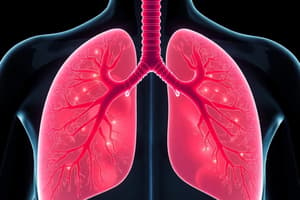Podcast
Questions and Answers
What is the primary function of the alveoli in the lungs?
What is the primary function of the alveoli in the lungs?
- To produce mucus that traps and removes foreign substances.
- To filter incoming air and remove foreign particles.
- To exchange oxygen and carbon dioxide between the lungs and bloodstream. (correct)
- To regulate the flow of air into and out of the lungs.
Which of the following is NOT a function of the circulatory system?
Which of the following is NOT a function of the circulatory system?
- Transporting oxygen to the body's cells.
- Producing red blood cells. (correct)
- Regulating body temperature.
- Removing waste products from the body.
What is the primary difference between arteries and veins?
What is the primary difference between arteries and veins?
- Arteries carry oxygen-rich blood, while veins carry oxygen-poor blood.
- Arteries carry blood away from the heart, while veins carry blood towards the heart.
- Arteries have thicker walls than veins.
- All of the above. (correct)
How does exercise improve heart health?
How does exercise improve heart health?
How do the respiratory and circulatory systems work together to provide oxygen to the body?
How do the respiratory and circulatory systems work together to provide oxygen to the body?
Flashcards
Main organs of the respiratory system
Main organs of the respiratory system
Includes nose, trachea, lungs, and alveoli, responsible for gas exchange.
Function of alveoli
Function of alveoli
Tiny air sacs in lungs where oxygen and carbon dioxide exchange occur.
Role of diaphragm in breathing
Role of diaphragm in breathing
Muscle that contracts to enable inhalation and helps expel air during exhalation.
Impact of smoking on the respiratory system
Impact of smoking on the respiratory system
Signup and view all the flashcards
Circulatory and respiratory systems cooperation
Circulatory and respiratory systems cooperation
Signup and view all the flashcards
Study Notes
Respiratory System
- Main Organs: Nose, pharynx, larynx, trachea, bronchi, and lungs.
- Functions: The nose filters, warms, and humidifies air. The pharynx and larynx are passageways for air and food. The trachea and bronchi conduct air to the lungs. Lungs contain alveoli for gas exchange.
Oxygen Intake & Bloodstream
- Oxygen enters through the nose.
- It travels down the trachea, bronchi and into the alveoli.
- Alveoli are tiny air sacs surrounded by capillaries (tiny blood vessels).
- Oxygen diffuses from the alveoli into the capillaries and into the bloodstream.
- Hemoglobin in red blood cells carries oxygen throughout the body.
Alveoli Function
- Alveoli are tiny air sacs in the lungs.
- Their thin walls allow for efficient gas exchange (oxygen and carbon dioxide).
- Huge surface area for gas exchange.
Breathing Mechanisms
- Diaphragm: A large, dome-shaped muscle below the lungs. Contracts and flattens during inhalation, increasing lung volume. Relaxes during exhalation, decreasing lung volume.
- Rib Muscles: Expand and contract the rib cage to aid with breathing. External intercostals contract during inhalation, expanding the chest cavity. Internal intercostals contract during exhalation, decreasing the chest cavity.
Smoking's Impact
- Smoking damages the alveoli and other lung tissues.
- Increases risk for respiratory diseases and lung cancer.
- Restricts airflow and impairs gas exchange.
Asthma
- A chronic respiratory disease characterized by inflammation and narrowing of the airways.
- Triggers can include allergens, irritants, or exercise.
- Symptoms include wheezing, shortness of breath, chest tightness.
Physical Activity & Lung Health
- Exercise strengthens respiratory muscles and improves lung capacity.
- Regular physical activity enhances lung function and efficiency.
Air Pollution & Respiratory Health
- Air pollution irritates airways, reducing lung function and increasing risk of respiratory illnesses.
Inhalation vs. Exhalation
- Inhalation: Air moves into the lungs. Diaphragm contracts.
- Exhalation: Air moves out of the lungs. Diaphragm relaxes.
Respiratory & Circulatory Systems Cooperation
- The respiratory system provides oxygen to the bloodstream.
- The circulatory system carries oxygen to all cells and removes carbon dioxide.
- The two systems work closely for continuous oxygen supply.
Circulatory System
- Main Parts: Heart, blood vessels (arteries, veins, and capillaries), and blood.
- Heart Function: A pump that circulates blood throughout the body.
- Heart Pumping Mechanism: The heart has four chambers that pump blood to and from the lungs and the rest of the body. The action of the heart is coordinated by electrical signals.
- Arteries, Veins, and Capillaries: Arteries carry oxygenated blood away from the heart, veins carry deoxygenated blood toward the heart, and capillaries are tiny vessels where gas exchange occurs.
Blood Circulation
- Blood travels through a closed loop—leaving the heart, carrying oxygen to the body, returning to the heart, and being pumped to the lungs for oxygen exchange.
Blood Components
- Red Blood Cells (Erythrocytes): Carry oxygen.
- White Blood Cells (Leukocytes): Part of the immune system and fight infection.
- Platelets (Thrombocytes): Help stop bleeding.
- Plasma: Liquid portion of the blood, transporting nutrients and waste.
Exercise & Heart Health
- Exercise strengthens the heart muscle, lowers blood pressure, and improves blood vessel health.
Circulatory Diseases & Prevention
- Heart disease, stroke, high blood pressure are common circulatory problems that can be prevented by maintaining a healthy lifestyle.
Blood Pressure Importance
- Maintaining healthy blood pressure is crucial to prevent heart attacks, strokes, and kidney disease.
Nutrition & Circulatory System
- A balanced diet rich in fruits, vegetables, and whole grains is essential for maintaining a healthy circulatory system.
Respiratory & Circulatory Systems for Oxygen Delivery
- The respiratory system brings oxygen into the lungs.
- The circulatory system carries this oxygen to the rest of the body.
Studying That Suits You
Use AI to generate personalized quizzes and flashcards to suit your learning preferences.




